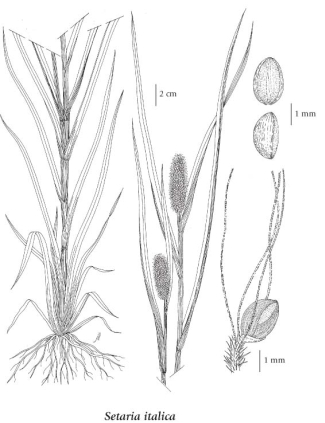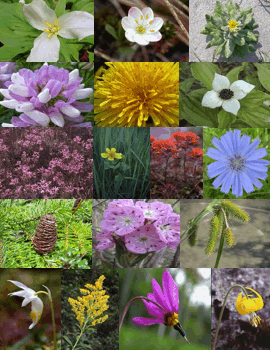Setaria italica (L.) P. Beauv.
foxtail millet (foxtail bristlegrass)
Poaceae (Grass family)
Introduction to Vascular Plants
foxtail millet (foxtail bristlegrass)
Poaceae (Grass family)
Introduction to Vascular Plants
Species Information
General:
Annual grass from fibrous roots; stems erect, with many nodes, 50-150 cm tall.
Leaves:
Sheaths cylindrical, smooth, densely fringed with long, fine hairs on the margins above the middle; blades flat to folded, 8-15 mm wide, 15-45 cm long, sparsely hairy at the base, pimpled on the upper surfaces, more or less pimpled on the lower surfaces; ligules fringed with long, white, silky hairs up to 3 mm long.
Flowers:
Inflorescence a cylindrical, nodding or nearly erect, spikelike panicle with the tips nodding, branched at the base, mostly 3-30 cm long, 1-3 cm wide, bearing numerous spikelets contiguously, or the basal few branches slightly spaced; spikelets 2-flowered, 2-3 mm long, each subtended by 2 to 4, green or blackish-green, short bristles that are from nearly as long as the spikelets to 4 times long as the spikelets, the hairs directed upwards; lower glumes 3-nerved, about as long as or 1/3 the length of the spikelets, the upper ones 5- or 7-nerved, 2/3 to 3/4 the length of the spikelets; lower flowers male or sterile, the upper fertile; fertile lemmas not distinctly cross-wrinkled, loosely surrounded by the sterile lemmas and upper glumes, tending to be shed separately from them.
Notes:
Closely related to S. viridis.
Illustration

If more than one illustration is available for a species (e.g., separate illustrations were provided for two subspecies) then links to the separate images will be provided below. Note that individual subspecies or varietal illustrations are not always available.
Illustration Source: The Illustrated Flora of British Columbia
USDA Species Characteristics
Flower Colour:
White
Blooming Period:
Summer
Fruit/Seed characteristics:
Colour: Brown
Present from Fall to Winter
Source: The USDA
Habitat and Range
Mesic to dry fields, roadsides and waste areas in the lowland zone; rare in SW BC; introduced from Eurasia.Status Information
Synonyms
Synonyms and Alternate Names:
Chaetochloa italica (L.) Scribn.
Panicum italicum L.
Setaria italica (Koern.) F.T. Hubbard
Setaria italica var. metzgeri (Koern.) F.T. Hubbard
Setaria italica var. metzgeri (Koern.) Jáv.
Setaria italica var. stramineofructa (F.T. Hubbard) L.H. Bailey
